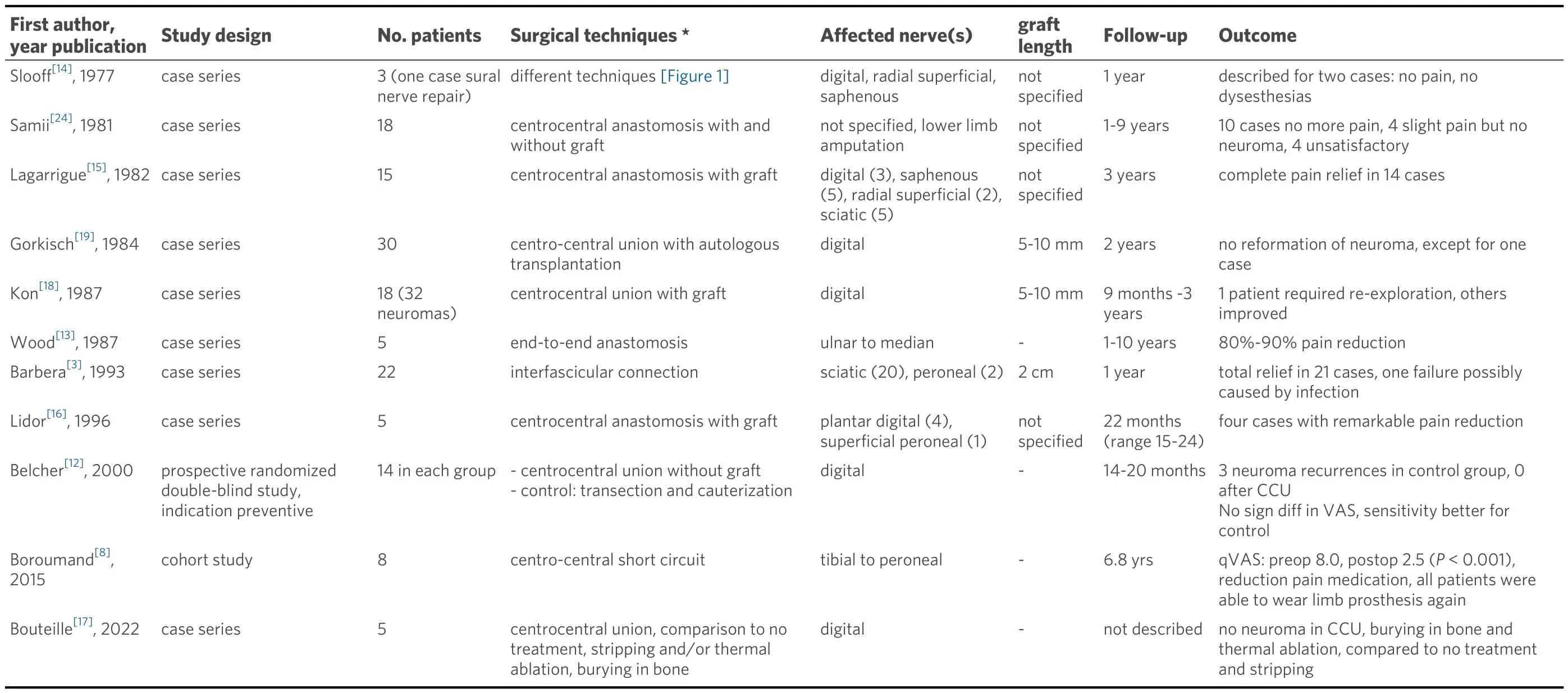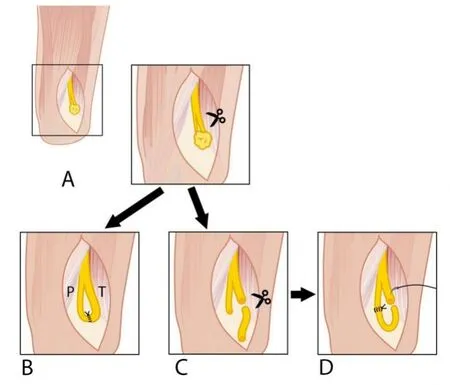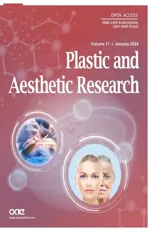Systematic review on the centrocentral anastomosis technique for the surgical treatment of traumatic neuromas
2024-05-18GodarddeRuiter
Godard de Ruiter
Department of Neurosurgery, Haaglanden Medical Center, The Hague 2501CK, The Netherlands.
Abstract Aim: Centrocentral anastomosis (CCA) can be applied in the treatment of painful neuromas, by connecting nerve ends or fascicles after neuroma resection, with or without an interposed nerve graft.While this technique was developed directly after the introduction of microsurgical techniques, it is currently not frequently applied in neuroma treatment.
Keywords: Neuroma, pain, centrocentral, union, neurorrhaphy, short circuit, termino-terminal suture, loop,interposed nerve graft
INTRODUCTION
Painful neuromas can develop following peripheral nerve injury.The formation of the neuroma itself is the result of the regenerative capacity of the peripheral nervous system.After nerve transection, proximal nerve axons regenerate to try to reach the distal nerve stump.In the initial stages of regeneration, this growth is completely disorganized, forming the so-calledPerroncito’s spirals[1].After reaching the distal nerve stump,axons re-organize, but in the absence of a distal stump, a disorganized bulb of axonal endings is left on the proximal stump, called a traumatic neuroma.Why in some patients this neuroma becomes symptomatic and in others not remains largely unknown, but bothchemical, e.g., target-derived neurotrophic factors[2],andmechanical stimuli, e.g., heterotopic ossification and scar tissue[3], may play a role.Traumatic neuroma can result in severe pain affecting every activity in a patient’s life.
In the surgical treatment of traumatic neuromas, there are several options.The traditional methods were largely based on resection of the neuroma and relocating the freshly cut proximal nerve stump into a different location, including muscle, fat, and bone tissue[4].More recently, novel techniques have been developed, including targeted muscle reinnervation (TMR) and regenerative peripheral nerve interface(RPNI)[5,6].
Centrocentral anastomosis (CCA) is an alternative surgical technique to treat painful neuromas.The concept was introduced by Samii during the development of microsurgical techniques in the 70s of the previous century[7].The first results appeared in the literature in the late 1970s / beginning of the 1980s.Despite the initial promising results, the CCA technique is not widely used in peripheral nerve surgery[8,9],possibly because surgeons are not aware of this technique, the technique can be technically difficult, or the evidence is weak.With novel options, such as 3D printed constructs that may facilitate CCA[10], this technique potentially becomes of more interest.
For this article, the existing literature on CCA was reviewed with specific attention to the different surgical techniques, potential applications, and pathophysiological mechanisms that have been mentioned in these articles, which can explain how CCA can prevent the recurrence of a neuroma.
METHODS
Systematic literature review
The literature was systematically reviewed according to the PRISMA guidelines[11].A Pubmed search was performed on August 1st, 2023, using the search strategy provided in [Appendix 1].All articles describing the results of CCA procedures, both clinical and experimental, were included.Review articles,commentaries, and studies on other surgical techniques were excluded.Articles or book chapters that were not found in the initial search, but were referenced in the selected articles, were also included.All articles(English and French) were read by the author and data on the type of study, number of patients or animals,surgical techniques (with or without nerve graft), follow-up, and outcome were collected.
RESULTS
The Pubmed search resulted in 15 articles.Two reviews, one commentary, and two articles on end-to-side anastomosis were excluded.In addition, 5 cross-references were included, resulting in a total of 15 articles:11 clinical and 4 experimental studies [Appendix 1].
Of the clinical studies, there were nine case series, one cohort, and one randomized study.Details are presented in [Table 1].The main indication for CCA in the clinical studies was the treatment of postamputation digital and lower limb neuromas.Other indications included preventive treatment (digital nerves)[12], neuroma treatment after wrist or forearm amputation (median to ulnar nerve)[13]and single neuromas of radial superficial, saphenous, superficial peroneal, and plantar nerves[14-16].Several techniques have been used, including direct coaptation of different nerves[8,12,13,17], connection with an interposed autologous graft[18,19], and opening of the epineurium with subsequently interfascicular connection, also with and without nerve graft[3,14,15][Figures 1 and 2].Different terms were used besides CCA, including centrocentral union, centrocentral neurorrhaphy, centrocentral short circuit, and termino-terminal suture.Follow-up periods were mostly around 1 year, but longer for the more recent cohort[8]and prospective randomized study[12].Only two studies have compared CCA to other techniques[12,17].The outcome in most studies was evaluated retrospectively using medical records for the success of subjective pain reduction and potential recurrence of neuroma.Only in two studies were results reported with an objective outcome measure for the improvement of pain measured with the visual analog scale[8,12].
Four experimental studies using the rat sciatic nerve model have investigated regeneration after CCA[10,20-23].Details are presented in [Table 2].In addition, descriptions from animal studies were provided in some clinical studies, but detailed information on the experiments performed was not provided[19,24].Most studies analyzed histologic results.In one study, pain was evaluated for autotomy scores[22].The animal studies produced several interesting observations.Barberaet al.compared CCA with and without nerve graft using different grafts: sural and peroneal nerve[20].After direct connection, disorganized growth was found at the suture site (neuroma), while after CCA with a graft, nerve fibers were distributed in a parallel fashion, both at the suture site and in the graft.After one year, axons inside the graft had almost normal size and myelination (no differences were found for the sural and peroneal nerve grafts) and no crossing of axons was observed the contralateral suture sites.Gil-Saluet al.used an anterograde Wallerian degeneration technique to investigate regeneration across the grafts[21].Sixty days after the CCA procedure, the graft was cut in the middle, and ten days later, the animals were sacrificed and the tissue underwent histomorphic analysis.The distribution of regenerative and degenerative axons was assessed in different segments of the nerves and graft.The results of this experiment showed that axons grew inside the graft from both directions and passed each other, but did not cross the contralateral suture lines.Gorkischet al.in a descriptive animal study (microscopic sections) found single axon proliferations from both parts of the nerve, lying parallel and interdigitating, in the autograft, and after an axonal overlap of 2 to 5 mm, this growth had ceased[19].Bolleboomet al.found decreased numbers of axons in the middle of the graft compared to the ends close to the suture sites[10].Finally, Gonzalez-Darderet al.created a neuroma model with two groups undergoing re-operation 5 days after transection.They found significantly less autotomy in the centrocentral anastomosis group compared to the control group, in which only the neuroma was resected[22].
DISCUSSION
This article reviews the literature on the centrocentral anastomosis (CCA) technique for the treatment of traumatic neuromas.This review shows that CCA has mainly been applied for the treatment of digital neuromas after finger amputation and sciatic neuromas after lower limb amputation.Different techniqueswere thereby used.

Table 1.Overview of the 11 clinical studies published on the subject of centrocentral anastomosis in the literature
Technical aspects CCA
Most important difference found in this review for the CCA technique was the use of an interposed nerve graft or not.In the connection of digital nerves, this graft was made after simple end-to-end repair of the two nerves, and subsequently transecting and repairing one of the nerves 5 to 10mm proximally[19][Figure 1].In sciatic neuroma, CCA has been performed by pairing fascicles (4, 6, or 8) that were dissected out of the main nerve and connected in pairs end toend[3].After direct repair, one fascicle was again transected 2cm proximal to the coaptation site and immediately re-sutured to create an interposed nerve graft.The alternative is to use either a segment of the tibial or peroneal nerve to create a CCA with interposed graft [Figures 2 and 3].

Table 2.Overview of the four animal studies published on the subject of centrocentral anastomosis in the literature
A nerve graft was not used in some studies.Belcher and Pandya reasoned that using a single coaptation has the advantages of simplicity and speed.However,the same authors noted that without a graft, the sprouting axon might not be able to penetrate the other endoneurial tubes which are still filled with axons,potentially resulting in axons penetrating into the neighboring connective tissue to again form a symptomatic neuroma[12].Boroumandet al.did not mention why a nerve graft was not used in their study to connect the tibial and peroneal nerves after resection of sciatic neuroma[8], but the patients in their cohort over the years tended to get slightly worse, probably attributed to axonal sprouting and a recurrence of neuroma.
Also in the repair of single nerve neuroma the technique of CCA with graft can be applied.Slooff has shown that this can be done by dissecting out separate fascicles from within the affter nerve after resection of the neuroma [Figure 1][14].This can be technically difficult[18], and it is necessary to have two nerves or fascicles of equal caliber to prevent the escape of axons at the coaptation site.Future biodegradable Y-shaped constructs might also be used to create a loop[10].In this technique, an extra segment of nerve is resected after neuroma resection, which can be inserted in the distal outlets as a graft.Subsequently, the freshly cut nerve end is placed in the proximal outlet, creating a closed loop.An additional advantage of this construct is that it would also prevent the escape of axons at the coaptation sites.

Figure 1.Original drawing from the article by A.C.Slooff from 1977, obtained with permission from Clinical Neurology and Neurosurgery[14].(1) Stump neuroma; (2) opening of the epineurium after resection of the neuroma; (3) the individual fascicles with surrounding perineurium; (4) separation of the fascicles; (5) CCA by an end-to-end interfascicular suture; (6) CCA with an interposed graft;(7) this graft can also be created after end-to-end connection (5) and subsequently transecting and directly repairing one of the fascicles in its proximal segment (7).

Figure 2.Illustration of the potential techniques for centrocentral anastomosis (CCA) of the tibial and peroneal nerves in the case of neuroma treatment after above-the-knee amputation.After resection of the neuromas from the distal ends of the tibial and peroneal nerves (A); these nerves can either be directly connected (B) or with the use of a graft (C), in which an extra segment of nerve is obtained from either the tibial or peroneal nerve and is placed between the transected nerve ends of these nerves (D).

Figure 3.Intraoperative pictures showing an example of surgical connection of the tibial and peroneal nerves with a graft for the treatment of traumatic neuroma years after an above-the-knee amputation.Intraoperative pictures showing (A) the neuroma at the end of the tibial and peroneal nerve, forceps holds the tibial part; (B) after resection of the neuroma, the tibial nerve end is marked 3 cm proximally to the freshly cut end (C) after connection of the tibial nerve end to the peroneal nerve end with two 10-0 sutures on the inner curve, the tibial nerve is transected at the marked site and directly repaired with 4x 10-0 sutures, (D) the end result after two extra 10-0 sutures have been placed at the tibial-peroneal coaptation site, and both coaptation sites have been sealed with fibrin glue(Tisseel, Baxter).This technique is slightly different from the illustration in [Figure 2], but has the advantage that the graft can be more easily handled.
Potential pathophysiologic mechanisms
This article reviewed experimental studies investigating regeneration after CCA.Results of these studies showed that axons regenerate into the graft in an orderly fashion from both sides, but that growth stops and that axons do not cross the contralateral coaptation site.Gorkischet al.hypothesized that this is caused by the intermingling of axons growing from both sites and that the growth stops because the axons in the area of the autologous nerve graft are under pressure resulting in a reduction of the protein production and axoplasm flow in the neuron[19].Gil-Saluet al.noted the impossibility of regenerating axons to find free bands of Büngner on the other side of the suture line[21].Woodet al.mentioned that suturing of two proximal nerves isolates the axons from target-derived neurotrophic factors and confines them to a nontarget environment, which could result in the cessation of regenerative efforts[13].Finally, another explanation could be that axons approaching each other from opposite directions in the same band of Büngner in the middle of the graft may inhibit each other’s growth[10].
Alternative techniques and different indications
There are several treatment options available to treat symptomatic neuromas.Eberlin and Ducic have developed a treatment algorithm, which largely depends on the availability of a distal nerve stump[9].In nonamputees, if the distal nerve is available, processed nerve allograft[25,26,27], biodegradable conduits[28], or muscle-in-vein conduits can be used[29].If the distal nerve end is not available or if the gap between the nerve ends is too long, traditional techniques such as relocation of the proximal stump into muscle, fat, or bone can be applied[4].Other alternatives are end-to-side anastomosis (connecting the nerve end onto itself after creating a window in the epineurium more proximally)[23,30], nerve capping[31], and TMR[32,33].A disadvantage of TMR is that it requires denervation of intact muscle tissue[34].
In amputees, there is an emerging role for TMR and RPNI[35].In a recent trial, TMR has shown promising results in the treatment of phantom limb pain[6].It is also increasingly applied for the prevention of neuroma formation directly after the amputation procedure, but TMR has the disadvantages of extra surgery time (approximately 1 extra hour) and the need for a peripheral nerve surgeon to perform this procedure[36].CCA would not have these disadvantages if an implantable device can be applied by the trauma or vascular surgeon that facilitates this procedure.
CONCLUSIONS
This literature review shows that CCA is a promising technique in the treatment of traumatic neuroma,especially for the treatment of digital and sciatic neuroma after amputation.Although the technique is not widely used, experimental studies have shown that especially CCA with an interposed nerve graft can provide an axonal trap[15]and thereby prevent neuroma recurrence.Currently, there are only a small number of retrospective case series and no prospective or randomized studies that have investigated the effectiveness of CCA with an interposed nerve graft.More research is therefore needed to further investigate this technique, preferably also with longer follow-up periods, standardized outcome measures, and comparison to other surgical techniques[37].Biodegradable conduits in the future may provide a construct that can facilitate the CCA technique with an interposed nerve graft.
DECLARATIONS
Author’s contributions
The author contributed solely to the article.
Availability of data and materials
Not applicable.
Financial support or sponsorship
None.
Conflicts of interest
The author holds a patent for the "nerve cassette", a novel biodegradable device to treat painful neuromas using the CCA technique.The author is an Editorial Board Member of the PAR journal.
Ethical approval and consent to participate
Not applicable.
Consent for publication
Not applicable.
Copyright
© The Author 2024.
杂志排行
Plastic and Aesthetic Research的其它文章
- Early lymphaticovenous anastomosis in lymphedema management: a pilot study
- The emerging role of sentinel lymph node biopsy in oral cavity and oropharyngeal carcinomas
- Therapeutic management of the painful nerve: a narrative review of common rehabilitation interventions
- Role of transoral robotic surgery in the salvage setting: pitfalls and challenges
- The mangled upper extremity: a principled approach to management
